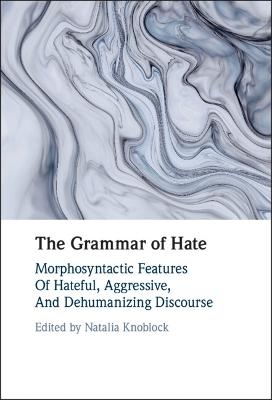
The Grammar of Hate
Cambridge University Press (Verlag)
978-1-108-83413-1 (ISBN)
Hate speech continues to be an issue of key social significance, yet while its lexical and discursive aspects have been widely studied, its grammatical traits have been hitherto overlooked. This book seeks to address this gap by bringing together a global team of scholars to explore the morphosyntactic features of hateful and aggressive discourse. Drawing on thirteen diverse cross-linguistic case studies, it reveals how hate is expressed in political discourse, slang, and social media, and towards a range of target groups relating to gender, sexual orientation, and ethnic identity. Based on ideas from functional and cognitive linguistics, each thematic part demonstrates how features such as morphology, word formation, pronoun use, and syntactic structures are manipulated for the purpose of expressing hostility and hate. An innovative approach to an age-old problem, this book is essential reading for researchers and students of hate speech and verbal aggression.
Natalia Knoblock is Associate Professor at Saginaw Valley State University. Her research interests lie in political and cognitive linguistics, sociolinguistics, and corpus-assisted discourse analysis. She is the editor of Language of Conflict (2020) and co-editor of the Journal of Language and Discrimination.
Introduction Natalia Knoblock; 1. Animacy and countability of slurs: shifting grammatical categories Natalia Knoblock; 2. Language aggression in English slang: the case of the -o suffix Elisa Mattiello; 3. Adj+ie/y nominalisations in contemporary English: from diminution to pejoration Elizaveta Tarasova and José A. Sánchez Fajardo; 4. Grammatical gender and offensiveness in modern Greek slang vocabulary Katerina Christopoulou, George J. Xydopoulos and Anastasios Tsangalidis; 5. Unseen gender: Misgendering of transgender individuals in Czech Jonáš Thál and Irene Elmerot; 6. The neutering neuter – grammatical gender in German and its discursive use in dehumanisation Miriam Lind and Damaris Nübling; 7. Neutering unpopular politicians: the neuter gender and 'it' as a dehumanizing grammatical metaphor Natalia Knoblock and Yaroslava Sazonova; 8. The power of a pronoun Linda Flores Ohlson; 9. Is play on words fair play or dirty play: on ill-meaning use of morphological blending Natalia Beliaeva; 10. Expressive German adjective and noun compounds in aggressive discourse: Morphopragmatic and sociolinguistic evidence from Austrian corpora Katharina Korecky-Kröll and Wolfgang U. Dressler; 11. “Kill the invaders”: imperative verbs and their grammatical patients in Tarrant's The Great Replacement Robert Bianchi; 12. 'I am no racist but…'. A corpus-based analysis of xenophobic hate speech constructions in danish and German social media discourse Klaus Geyer, Eckhard Bick and Andrea Kleene; 13. Homophobic space-times: Lexicogrammatical and discourse-semantic aspects of the softscapes of hate David Peterson.
| Erscheinungsdatum | 04.07.2022 |
|---|---|
| Zusatzinfo | Worked examples or Exercises |
| Verlagsort | Cambridge |
| Sprache | englisch |
| Maße | 158 x 235 mm |
| Gewicht | 600 g |
| Themenwelt | Geisteswissenschaften ► Sprach- / Literaturwissenschaft ► Sprachwissenschaft |
| ISBN-10 | 1-108-83413-2 / 1108834132 |
| ISBN-13 | 978-1-108-83413-1 / 9781108834131 |
| Zustand | Neuware |
| Informationen gemäß Produktsicherheitsverordnung (GPSR) | |
| Haben Sie eine Frage zum Produkt? |
aus dem Bereich


